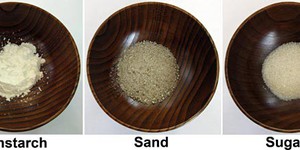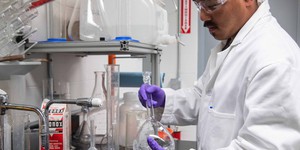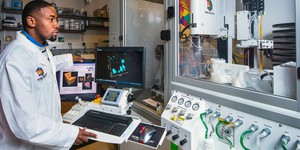Summary
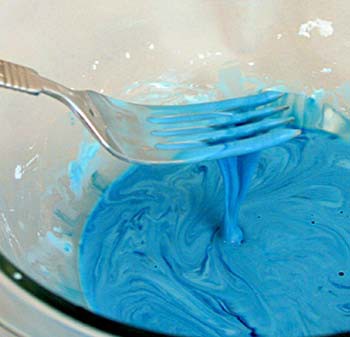
Introduction
Have you ever wondered what whipped cream, jelly, and milk have in common? Aside from all being tasty, they are also all made up of tiny particles that are dispersed, or distributed, in water. This type of mixture is called a heterogeneous mixture. Some of these have very interesting physical properties, such as acting like a solid and a liquid at the same time! In this activity, you will get to create Oobleck, a mixture that is made using cornstarch and water, and then explore these properties first-hand!Materials
- Small bowl or cup
- Cup, mug, or drinking glass
- Fork
- Medicine dropper
- Measuring spoon
- Cornstarch
- Water
- Optional: food coloring or tempera paint
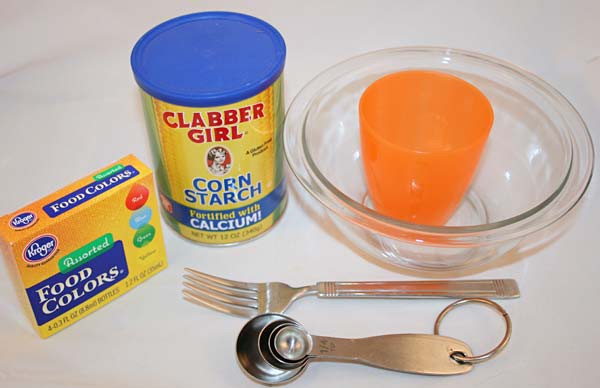 Image Credit: Sandra Slutz, Science Buddies / Science Buddies
Image Credit: Sandra Slutz, Science Buddies / Science Buddies
Instructions
- Add 1 tablespoon of the cornstarch to the small bowl or cup.
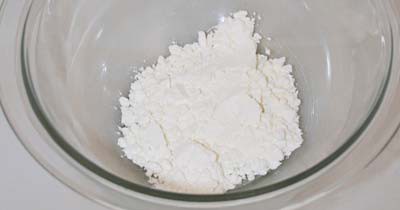 Image Credit: Sandra Slutz, Science Buddies / Science Buddies
Image Credit: Sandra Slutz, Science Buddies / Science Buddies
- Fill the empty cup, mug, or drinking glass with water.
- Use the medicine dropper to add water from the cup to the small bowl with the cornstarch. Add the water one drop at a time, counting as you go.What happens as the water touches the cornstarch?
- After you have added 20 drops, stir the cornstarch with the fork. Break up any clumps that formed.
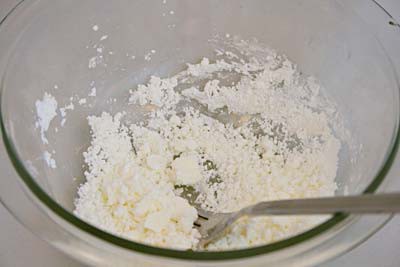 Image Credit: Sandra Slutz, Science Buddies / Science Buddies
Image Credit: Sandra Slutz, Science Buddies / Science Buddies
- Keep adding drops one at a time, stirring with the fork after every 20 drops. What happens as you add more water?
- Once you have added 100 drops of water total, stop for a moment and observe the cornstarch.How does the cornstarch look now? How has it changed?
- Continue adding drops, but now mix the cornstarch after every 10 drops.
- Stop adding water when it looks like all of the cornstarch in the bowl has turned into Oobleck, or like all of the cornstarch has flowed together like a liquid. It will probably take around 150 to 170 drops of water total. How many drops did it take for you? How would you describe how the Oobleck looks?
- Play around with the Oobleck in the bowl. Poke it with your finger and put some on your fork or in your hand. If you want to color your Oobleck, add a few drops of food coloring. Tip: If it seems to get chalky while you are investigating it, try adding and mixing in a few more drops of water.How does it move? What does it feel like? What do you think this tells you about Non-Newtonian fluids and their physical properties?
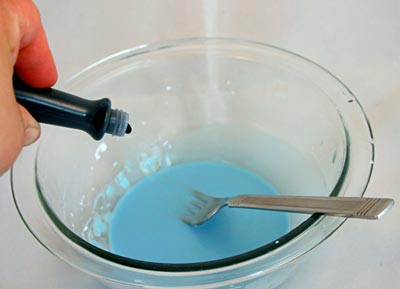 Image Credit: Sandra Slutz, Science Buddies / Science Buddies
Image Credit: Sandra Slutz, Science Buddies / Science Buddies
- Optional: If you want to explore the behaviors more, or are doing this with preschool-age children who love a messy adventure, make a larger batch of Oobleck in a pie tin or cookie sheet. Add drops of food coloring directly to the Oobleck and try mixing them with your fingers.
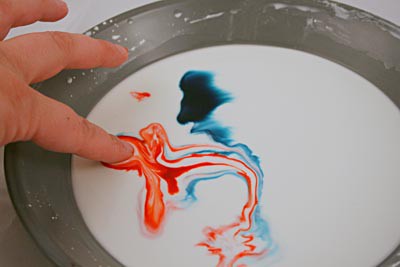 Image Credit: Sandra Slutz, Science Buddies / Science Buddies
Image Credit: Sandra Slutz, Science Buddies / Science Buddies
Cleanup
What Happened?
The Oobleck you made in this activity is a non-Newtonian fluid, which means it does not act like most fluids (water, juice, liquid detergent etc) you interact with. When most liquids are pushed against, like how you poked the Oobleck with your finger or fork, they move out of the way. Additionally, the harder they get pushed, the faster the liquids move out of the way. Water, and most fluids, are Newtonian fluids and behave in this way. However, since the Oobleck is a non-Newtonian fluid you should have seen that it does not behave like this. When you put stress on it, such as by pressing down on it or poking it with the fork, it became harder, changing into a solid. When you did not poke at it, but instead just placed some on your fork or held it in your hand, the Oobleck again changed, this time becoming a runny liquid. The more pressure you put on the Oobleck the more solid-like it becomes.Digging Deeper
In addition to being a non-Newtonian fluid, Oobleck can be called a heterogeneous mixture. Usually one of two things happen when you mix a solid and a liquid: the solid either dissolves or it separates from the liquid. You have seen this before. For example, if you mix salt with water the salt disappears—it completely dissolves such that the water and salt can no longer be separated. Such a mixture is called a homogeneous mixture, or solution. In contrast, heterogeneous mixtures are not uniform in composition. If you mix particles larger than 1μm, such as sand with water the sand does not dissolve. After you stop mixing the sand eventually settles to the bottom of the container—it separates from the liquid. A heterogeneous mixture with suspended particles large enough to settle down to the bottom of the container upon standing (usually >1μm) is called a suspension. In the cornstarch-water mixture individual tiny particles of cornstarch are suspended throughout the water. The cornstarch pieces are very tiny, with an average size of 1500 nanometers in diameter. (A nanometer is very small — a human hair is about 100,000 nanometers wide!) In Oobleck, the cornstarch pieces are evenly spread throughout the water. These particles are so small that you cannot see them with the naked eye. Suspensions with dispersed particles smaller than 1μm are called a colloid, which means that the particles are so small that they cannot be separated from the mixture anymore. They won't settle upon standing and can't be filtered out. Although a colloid looks like the liquid is all one thing, you can see under a microscope that it is actually a mixture of particles suspended in a liquid.
Having the right particle size is important for making a colloid. If smaller particles are used, they will dissolve in the water and not be visible, even with a microscope. For example, think of how sugar dissolves in water, making a homogenous solution. On the other hand, if larger particles are used, such as grains of sand, they will not dissolve in the water. Instead, they separate from the water, and are so large that they form a heterogeneous mixture of particles that can be seen with the naked eye. Some particles are just the right size to make a colloid with water. Depending on the particle size of the cornstarch you used in your experiment, you either made a colloid or a suspension. You can easily find out by letting your cornstarch-water mixture sit for some time. If the cornstarch separates from the water, the cornstarch particles are large enough to settle down, which means you made a cornstarch-water suspension. If you do not see any separation at all, you have made yourself a colloid!
Side note: The name Oobleck comes from the Dr. Seuss story Bartholomew and the Oobleck. The Dr. Seuss tale, which makes a fun literary tie-in to this science activity, features a king whose wishing for something new and more exotic than rain or snow to fall from the sky results in a problematic, sticky Oobleck rain and an ordinary boy, Bartholomew Cubbins, who must save the kingdom.
Ask an Expert
For Further Exploration
- Colloids and suspensions can be made out of many common products. Which compounds can you find that make a colloid? What products make a suspension when mixed with water? How do these compare to the mixture you made using cornstarch?
- Starches are often used to make gels. Try heating up the Oobleck and see what happens. How does it change? Are there new physical properties that you can observe?
- Clay soil behaves like a colloidal material when it has just the right amount of water in it. You could try making a colloidal clay soil solution and test the effect of different forces on it. Colloid solutions can appear solid against strong downward forces, but weak against lateral forces that push sideways. In which direction is your colloid solution the weakest? If your sample were clay soil in the real world, how could this contribute to landslides or earthquakes?
Related Resources
Project Ideas
Links
- Blog Post: Slime, Catapults, and Halloween Science
- Blog Post: April 1 Science: April Fools' Day Inspiration


